Alcan Highway Completed
Beginning with the attack on Pearl Harbor, and worsened by the attempted bombing of Santa Barbara and the successful bombing of Fort Stevens, wartime hysteria and fear of an enemy invasion knew no bounds. These attacks led the War Department to consider all of the nation’s vulnerable points, and at the top of that list was the then-territory of Alaska. Overnight, the territory gained value to both Americans and the Japanese alike. Just 750 miles away from Attu was a Japanese naval base, making the threat of the region being invaded and taken, and subsequently—perhaps—the rest of North American—a not-so-unrealistic fear.
The idea of a route connecting mainland United States to Alaska was not a new idea. In fact, it had been proposed in the ‘20s. But it wasn’t until February 1942 that the construction was approved by Roosevelt, only after working out an agreement with the Canadian government as well. Before the Alcan Highway (also called the Alaska Highway or the Alaska-Canadian Highway), the only way to supply US troops stationed in Alaska was by sea or air. If shipping lanes on the northwest coast were successfully interrupted by the enemy, or even by some unlucky circumstance for that matter, Alaska could easily fall. It was seen as a national defense problem. Construction work began in March, and was hastened with Japanese actions in the Alaskan islands of Kiska and Attu in June 1942.
Once completed, the Alcan Highway was a 1500-mile route between Dawson Creek, British Columbia to Fairbanks, Alaska. It was built by the skillful hands of 7 Army Corps of Engineer regiments totaling more than 10,000 men, nearly 35% of whom were African Americans excluded from combat roles. Once arriving in the more-often-than-not icy terrain, these troops often had to relearn simple tasks that were made nearly impossible by the ice, snow, and miserable conditions of the region.
Though the Alcan Highway completed on this day 70 years ago, it wasn’t officially opened until 20 November 1942. Though its construction was a necessary and impressive feat, driving the snow-covered highway was nearly as difficult as building the route had been. Construction troops often had to shovel out the road, even in temperatures dozens of degrees below zero. Accidents and flipped vehicles were a common sight. Tow cars worked 24 hours a day rescuing stranded vehicles and pulling them out of ditches. Quartermaster troops were stationed at every 100-mile mark to aid in servicing vehicles, though they were not always well-enough equipped to address the problem.
After the route’s completion, civilian contractors continued work on the route to make it more permanent and better able to sustain the intense weather of the Alaska-Canadian wilderness. The route was opened to the public in 1948, after being made safe enough. Today, the entire route is paved.
Image Gallery
Images from a unit history of an engineer regiment that worked on the Alcan Highway. Gift of Ben Cohen, 2011.051.
- "A heavy log for a corduroy road bed at the J-35 mile mark is carried by seven husky Company C men. After a job like this, chow and sleep were always welcome."
- Comfort was in short supply for men working the Alcan. Here a Private bathes in an improvised tub.
- Building a box culvert in knee-deep mud and water. The platoons flipped coins for jobs like this, and these boys lost.
- Men wait for the inevitable time when ice flows will sweep the bridge from its moorings.
- Officer's mess.
This post by Curator Meg Roussel
- Posted :
- Post Category :
- Tags : Tags: African Americans in WWII
- Follow responses to this entry through the RSS 2.0 feed. You can skip to the end and leave a response. Pinging is currently not allowed.


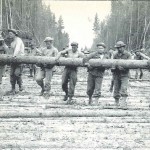
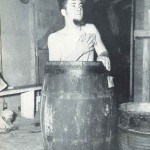
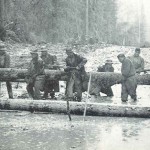
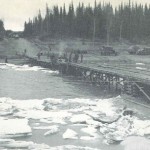
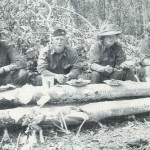
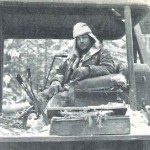


Leave a Reply